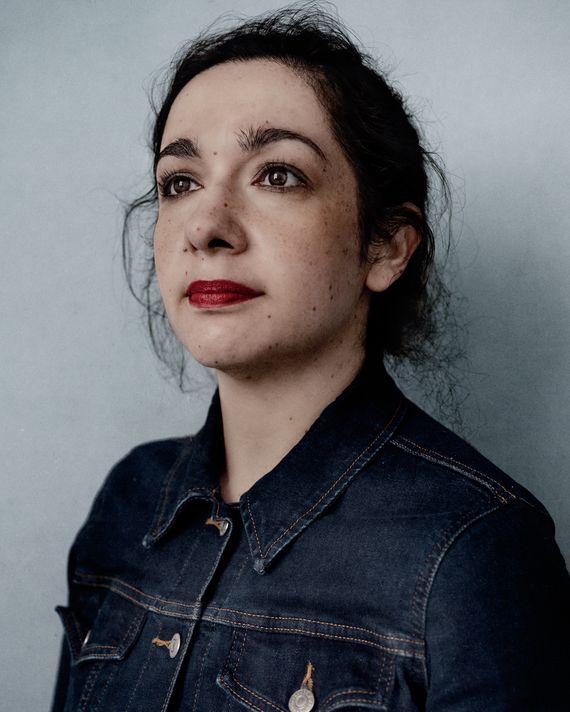
This article was featured in One Great Story, New York’s reading recommendation newsletter. Sign up here to get it nightly.
Lee la noticia en español aquí.
The scene opens on a kid named Milton. He lives in a poor neighborhood near the coast of Veracruz, Mexico, where there’s a gang that strikes such fear into civilians that they refer to its members only as aquellos, or “them.” One night, a group of gang members abducts Milton from in front of his home and interrogates him with electric shocks until he pees himself. Then they give the terrified kid clean clothes and send him out on his first job as a professional killer.
But first, they need a car. So one of the sicarios hails a taxi, puts a gun to the driver’s head, and throws him into the trunk. Four guys pile in, and they start driving, knocking delivery drivers off their motorbikes, making off with the bikes one by one until only Milton and the boss, El Sapo, are left in the cab. They pull onto an unpaved road at the edge of the city, drag the taxi driver out of the trunk, and throw him to the ground. “Flick the safety off,” El Sapo says to Milton, his pistol trained on the kid even while he’s handing him another pistol from his waistband. The driver has his face to the ground, and he’s praying: “Dios te salve, reina y madre de misericordia.” Milton completes the prayer in his head: Vida, dulzura y esperanza nuestra. He fires off four shots — his first murder.
This is one of the most shocking sequences in Fernanda Melchor’s latest novel, Paradais. It’s also partly true. Melchor, who grew up in Veracruz, says she heard the story from a friend, who heard it from a taxi driver — which is typical for this friend, whom Melchor calls “the taxi psychologist.” (“He gets in the cab, asks a question, and the driver starts going off.”) The main difference between reality and Melchor’s version is that in Paradais, the taxi driver doesn’t live to tell the tale. “I’m a story collector,” she tells me. “A lot of what I do is go to Veracruz and listen to what people are saying. There are a million things worth writing just based on that.”
As we speak, Melchor is in Berlin on a fellowship, but she’s usually based in the city of Puebla, Mexico. Over the past few years, she has steamrollered her way to the top of that country’s literary scene with harrowing but compassionate depictions of true-crime stories. Whereas some novels (say, American Dirt) populate Mexico’s post-drug-war period with ruthless criminals and the innocent villagers they terrorize, Melchor’s books feature characters who are more than victims and villains. Writing in Spanish, she avoids the sensational, even when depicting violence in extreme detail. She shows instead how ordinary these episodes have become — and that makes them even scarier.
Her breakthrough novel, Hurricane Season, was published in English translation in 2020 and opens with a group of children discovering the gas-bloated corpse of a witch lying in an irrigation canal before working backward to uncover the small-town drama that led to this. On May 10, Melchor publishes the English-language version of Paradais, which is set primarily in a world she knows intimately: a Veracruz luxury development insulated from its surroundings by barbed wire and security guards. The writer, who grew up in a middle-class family, reconstructed the setting from memories of birthday parties and after-school hangouts with wealthier friends from her private high school — “the kind of people whose parents owned hotels.” But there’s nothing distinctly Mexican about a gated community. It’s a universal feature of any place with a distended wealth gap.
Melchor has a ventriloquist’s flair for dialogue that makes her characters crackle and pop. (This carries through in English as well, thanks to translator Sophie Hughes.) She writes in a close third person, in paragraph-long sentences and chapter-long paragraphs, in a voice that shifts subtly to match the character she’s trained on at any given moment. As a result, it feels like you’re simultaneously inside and outside a character’s head, experiencing in high definition the pathos that drives each (usually bad) decision and the chain reaction set off as a result.
Francisco Goldman, a New Yorker contributor and author of numerous fiction and nonfiction books, first met Melchor at the Guadalajara Book Fair. He was struck by her choice to live in Puebla — “a laudable distance from the literary world” — and by her magnetism. “You read her, and it feels like you’re in a thunder-and-lightning storm,” says Goldman. “You know how people say, ‘That person has talent to burn’? Well, it’s like she just burns and burns and burns and never runs out. She’s relentless.”
It all started with an essay contest. In 2003, the Mexico City newspaper La Jornada published a call for young journalists to submit essays on the subject of vigilante justice with a promise to print the winning entries. Melchor was 19 and in her second year of journalism school at the University of Veracruz, frustrated by her professors who never sent students into the field. “In Mexico, journalism is something you only learn by doing it,” she says. “I wanted to get out there.”
At the time, she imagined herself as a writer of crónica, a Latin American nonfiction genre that draws on the interpretative storytelling of literature, theater, and memoir. She’d always loved chisme, the kind of gossip that gives you a bird’s-eye view of what’s happening in the proverbial town square. As Melchor contemplated what to submit to the essay contest, she was reminded of an incident that had happened six years prior in a remote village near the Veracruz-Oaxaca border: Residents of Tatahuicapan (population 236) had accused a man of attempting to rape and then murdering a woman, his neighbor, in broad daylight. Rather than turn to the legal authorities, the woman’s friends and family members tied the man to a tree, tortured him until he confessed, then doused him with gasoline and set him on fire. The townspeople didn’t see this as a lynching: They’d formed their own sentencing committee, collecting nearly 200 signatures from neighbors in favor of this punishment. They even taped the process with a VHS camcorder, and the video ended up in the morning news on the national network TV Azteca.
Melchor thought the story was “terrifying, fascinating, and kind of beautiful.” On the one hand, only the state is supposed to prosecute people. But in Mexico, where the overwhelming majority of femicides go unpunished, the episode looked like a blow against impunity. Melchor wanted to report it out, Truman Capote style. She’d never actually done any reporting, though, so she called up an older journalism student, who offered to show her the ropes. “Of course, what the guy really wanted was to sleep with me,” she says, “but we ended up doing great work.” Her story won second place in the contest.
A reedited version of that piece appears in Melchor’s 2011 collection Aquí No Es Miami (“This Is Not Miami”), her only strictly nonfiction book. In the book’s prologue, she stresses that although the work is based on vigorous reporting, she doesn’t see it as journalism. “In Mexico, journalism is still tied to this old-school fantasy that journalists can be fully objective, as if you could become this floating eye with no body, no past, and no ideology of your own,” she says now. “To me, it seems ridiculous. What you have to do is use your subjectivity and take advantage of it.” For years, Melchor haunted the cantinas and drug dens of Veracruz, where dock workers would regale her with local lore. She kept a file of stories that might serve as writing prompts — first as a binder of clippings, now as a folder on her computer. She had always written fiction, even before she started reporting. Soon she decided to return to it: In 2013 she published her first novel, Falsa Liebre.
Her next book, Hurricane Season, was inspired by a story from the nota roja, Mexico’s shameless crime tabloids. The news story was about a man who murdered someone he believed was a witch; he was convinced the witch had cast a spell on his wife. “That detail for me was like, Whoa!” she says. “The story wasn’t just the putrefied corpse with its throat slit—that’s the least interesting part — but the love triangle behind it.” The novel she wrote takes place within the bounds of one mosquito-bitten Veracruz village, charged with an atmosphere of misogyny and homophobia, and is narrated in the shockingly vulgar, rhythmically baroque street slang of jarochos, as Veracruz residents are called. In Spanish, Melchor’s sentences are packed with regionalisms. There’s a scene where one prisoner taunts another, “Órale, pinche mayate, o te caes con los cacles o te lleva la verga.” Hughes’s English translation: “Cocksucker, give me your fucking shoes or I’ll fuck your ass so hard you won’t know what day it is.”
Working backward from the book’s climactic murder, Melchor reveals the mind-warping effects of living in a toxic miasma. We learn that the witch who was killed was trans and a folk healer; she lived alone in a house rumored to hide priceless treasure. The book’s characters face both crushing deprivation and constant reproach at not behaving as a real man, or a real woman, should. To write it, Melchor reproduced the language of machismo she’s been hearing her whole life. “When I found out they were going to translate Hurricane Season to English, “I thought, Uh oh. In this politically correct culture, what if people read this book and think that I’m the misogynist, racist, classist one?” she says.
“I feel quite adamant that there is no poverty porn in this book,” Hughes says of Hurricane Season. “Here’s an author who’s trying to show us where violence might stem from, how the kernels of hatred begin in a particular setting. She’s the one who’s going to the effort to try and unpick the seeds that come in to the lives of these people. To me, it’s an act of generosity.” Writing this way takes its toll. After Melchor finished that novel, she started going to therapy. “It was like swatting a hornet’s nest,” she says. “It detonated a series of emotions and conflicts inside me that I wasn’t ready to feel or even admit to myself.”
Having exploded on the scene with a book in which violence and poverty are linked, Melchor wanted to write about how evil transcends class. That’s how she arrived at Paradais, an upstairs-downstairs novel told from the perspective of two teenagers, whom Melchor jokingly referred to as “tropical Beavis and Butt-head”: Franco, an emotionally stunted porn addict who lives in the upscale housing development, and Polo, a high-school dropout who works there. They have nothing in common except that Polo’s old enough to buy booze and Franco’s got money to pay for it. At nights, they drink themselves blind in an abandoned mansion — one inspired by a house that a teenage Fernanda and her friends used to call the “Casa del Diablo,” where they would take mushrooms and dance to techno until dawn. In the book, the boys believe it’s haunted by the Bloody Countess, a colonial aristocrat killed as revenge for kidnapping and torturing enslaved boys and men.
Paradais is, in part, an homage to one of Mexico’s most widely read novels: José Emilio Pacheco’s Battles in the Desert, from 1981, about a Mexico City teen who falls in love with his best friend’s mother. Whereas Pacheco only alludes to carnal desire, Melchor makes it her book’s engine. Franco, who spends his days locked in his air-conditioned room, “farting and watching porn on his new laptop,” becomes obsessed with his married next-door neighbor, Señora Marián; he thinks she makes his favorite porn star seem like “your average crack whore” by comparison. Meanwhile, Polo is stuck sleeping on a straw mat in a house he shares with his mother and his older female cousin, and he wants to get far away from it all. So the two hatch a cockamamie plan to get what they each want.
Melchor spent a lot of her teenage years around boys like these. She would have once compared herself to Beverly Marsh, from Stephen King’s novels, or Eleven from Stranger Things — the one girl who hangs out with the guys. This had once been her way of finding acceptance and to escape the stigma of being a tomboy. As she grew up, however, she began to question why she always gravitated toward men, why they were the mystery she was trying to solve. The stakes of that question became much higher several years ago, when she became the stepmother to her partner’s young daughter. “I never saw how we reproduce verbal violence from one generation to the next without realizing it, so for me this was an opportunity to break the cycle,” she says. “I grew up thinking I was a second-class citizen, and I didn’t want her to grow up like that. I had to confront my own discourse.”
In Paradais, Señora Marián and the Bloody Countess represent what she sees as the two faces of patriarchy: desire and fear. “It’s a primitive fear, atavistic even, toward women and their reproductive capacity,” she says. “It’s like that dumb joke: ‘How can you trust anything that bleeds for five days and doesn’t die?’ ” The book envisions a nightmare scenario of what could happen when those forces are allowed to build until they burst. Melchor worried that it could become pornographic; she scrapped the end of the book twice before she nailed it, drinking while she wrote to make herself confront it. She’s already thinking about the kind of story she might tell next time. “I want to write a tragedy that doesn’t necessarily resolve as a tragedy. Maybe,” she says, “something a little more hopeful.”
Hair and makeup by Felix Stößer for Basics Berlin.




